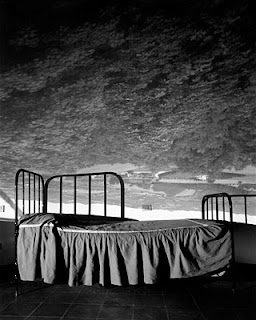"The great mystery of the world is not the invisible, but the visible." Oscar Wilde
The presencing of things, their announcement of themselves, quietly, phenomenally, can be extraordinary. As though always there, yet un-captured, un-assailed, these fugitive elements are momentarily held, crystallised. Even then, their ephemeral nature means they are always already departed. An instant, from the corner of the eye, then gone.
The presencing of things, their announcement of themselves, quietly, phenomenally, can be extraordinary. As though always there, yet un-captured, un-assailed, these fugitive elements are momentarily held, crystallised. Even then, their ephemeral nature means they are always already departed. An instant, from the corner of the eye, then gone.
 Abelardo Morell, Umbrian Landscape Over Bed, Umbertide, Italy, 2000
Abelardo Morell, Umbrian Landscape Over Bed, Umbertide, Italy, 2000Abelardo Morell's photographs make manifest such evanescent presences. Converting interior spaces into camera obscuras he then photographs the ensuing scene. Entering the room through a tiny pin prick in the blackened out windows, the light forms an inverted image upon the interior scene. A small pinhole creates a small yet highly focussed image, and a larger hole gives a more diffuse image. Remarkable coincidences are limned within the space. Surreal, ethereal and fleeting ...

Abelardo Morell, La Giraldilla de la Habana in Room With Broken Wall, 2002
The images which enter the darkened room through the tiny hole are then gathered into the photograph, with exposures of around 8 hours, recalling Hubert Damisch's words on the phenomenology of photography.
Morell reveals the magic secret behind the small dots of light that fall upon the ground under trees. The dappled sunlit is made up of multiple pinhole images of the sun, making their way through gaps in the foliage above. At times of eclipses this becomes even more mysterious, as the miniature views of the sun become crescent shaped, showing the shadow of the moon.

Abelardo Morell, Shadows During Solar Eclipse, Brookline, MA, 1994

Images from Library of Dust, by David Maisel
Another set of photographs which is phenomenally alive, inflected with the mysteriousness of metaphysics as much as physics, is the project The Library of Dust, by photographer David Maisel, and including the writings of Geoff Manaugh. The eerie images are of the cremated remains of patients from a mental asylum which had been kept in copper canisters. Left unclaimed for decades, the canisters began to develop eerie, uncanny surface colourings. Surreal micro-landscapes of psychedelic flora, phosphorescent efflorescences. One imagines a re-writing of Breton's declaration:
"Beauty will be CORROSIVE or will not be at all!"

David Maisel, Library of Dust
“He deepens a seam or fault line, in the night of the inapparent, in order to extract, lovingly or more often by force, with strokes and patches of color, blocks of the visible.” Jean-Luc Marion





